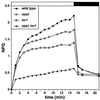The roles of specific xanthophylls in photoprotection
- PMID: 9391170
- PMCID: PMC28450
- DOI: 10.1073/pnas.94.25.14162
The roles of specific xanthophylls in photoprotection
Abstract
Xanthophyll pigments have critical structural and functional roles in the photosynthetic light-harvesting complexes of algae and vascular plants. Genetic dissection of xanthophyll metabolism in the green alga Chlamydomonas reinhardtii revealed functions for specific xanthophylls in the nonradiative dissipation of excess absorbed light energy, measured as nonphotochemical quenching of chlorophyll fluorescence. Mutants with a defect in either the alpha- or beta-branch of carotenoid biosynthesis exhibited less nonphotochemical quenching but were still able to tolerate high light. In contrast, a double mutant that was defective in the synthesis of lutein, loroxanthin (alpha-carotene branch), zeaxanthin, and antheraxanthin (beta-carotene branch) had almost no nonphotochemical quenching and was extremely sensitive to high light. These results strongly suggest that in addition to the xanthophyll cycle pigments (zeaxanthin and antheraxanthin), alpha-carotene-derived xanthophylls such as lutein, which are structural components of the subunits of the light-harvesting complexes, contribute to the dissipation of excess absorbed light energy and the protection of plants from photo-oxidative damage.
Figures




References
-
- Britton G. FASEB J. 1995;9:1551–1558. - PubMed
-
- Green B R, Durnford D G. Annu Rev Plant Physiol Plant Mol Biol. 1996;47:685–714. - PubMed
-
- Grossman A R, Bhaya D, Apt K E, Kehoe D M. Annu Rev Genet. 1995;29:231–288. - PubMed
-
- Jansson S. Biochim Biophys Acta. 1994;1184:1–19. - PubMed
-
- Paulsen H. Photochem Photobiol. 1995;62:367–382.
LinkOut - more resources
Full Text Sources

